Symbolism and Plants
Plants in spirituality and divinity.
Though plants are necessary to humans for survival in the form of food and medicine, not all plants that we use are so directly tied to our base biological needs.
For as long as humans have been on this earth, we have searched for ways to make meaning from—and understand—the world around us. Through time, we have developed a range of religious systems and practices that reflect our varied spiritual beliefs, which have foundations in and represent the different environmental and cultural backgrounds in which communities and civilizations have developed. As these different belief systems arose, the use of different plants native to those parts of the world developed with them. In some cases, these plants have served as symbols of deities or idols, while in others, they have been holy sacraments or tools in religious rituals. No matter what role they have played, the use of plants for religious and spiritual purposes is undeniably of great importance, and perhaps one of the most defining features of humanity’s relationship with the world of plants around us.
There are far too many religions and belief systems to be able to recount them all here, but there are many that are well known today with a deep history connected to plants that especially warrant examining. Often religious texts feature many plants that play a symbolic role or are used in important stories. The most printed and widely read book on the planet is the Christian Bible, which mentions around 200 different plants throughout its stories. The book Plants of the Bible by Michael Zohary discusses plants mentioned in the Old and New Testaments and their roles in biblical society, with 200 full-color plates of the plants. It is considered by some to be the most comprehensive book ever published on the subject.
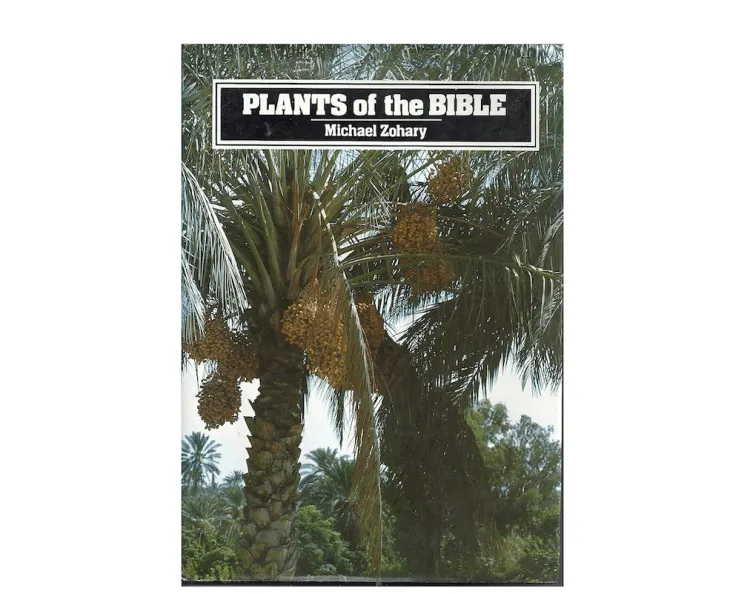
"Plants of the Bible" gives information on the role of plants used in the Christian Bible with full-color plates taken in their natural habitats. It discusses plants used in worship, agriculture, ancient trade systems, and the seasons and climate of the landscape where plants were sown in biblical society. It is available in the Howe Library.
Ultimately, Christianity is one belief system of many on the planet. There are many plants that have widespread importance beyond a single spiritual setting, holding symbolic or spiritual meaning in several widely practiced religions. One example of these is the lotus flower (Nelumbo nucifera). The lotus flower is depicted with many Hindu deities, with the figures either holding the flower or standing atop them. The flower is representative of spiritual enlightenment and serves as a symbol of fertility and rebirth to Hindus. The lotus has similar themes in Buddhism, representing the enlightened mind and righteousness as the flower traditionally grows out of muddy swamps and marshes, but the petals often still appear pristine. The species is native to southeast Asia and parts of Australia, and has been used in many ways in these cultures. The entire plant is edible and the starchy rhizome can be prepared many ways and used in soups or curries, or the leaves of the plant can be dried for tea. The lotus is also known for its antioxidant properties and is consumed for immune support or as anti-inflammatory.

This is the Pringle Herbarium’s only specimen of the lotus flower, "Nelumbo nucifera". It was collected in 1995 in South America. Only the flower is included in this specimen, as leaves and roots are absent. The flower grows on a separate stem from the leaves of the plant, and it roots at the bottom of a shallow body of water.
There are two evergreen trees native to South Asia that have influenced many religious beliefs within and around the Indian subcontinent. One of these is the Ashoka tree. There are two main species of the tree that are both referred to by this name, Saraca asoca and Saraca indica. The tree is often found planted outside Buddhist and Hindu temples, and it is said that Gautama Siddhartha, the founder of Buddhism, was born beneath this tree. The common name “Ashoka” or “Asoka” means “without sorrow” in Sanskrit, and this tree is believed to be able to take away sorrows and worries. It is also associated with the Hindu god, Kamadeva (the god of love), who keeps the flowers from the tree as arrows in his quiver.
Another tree of sacred importance is Ficus religiosa, commonly known as the sacred fig or peepal tree. It has been introduced in some places beyond its native habitat of the Indian subcontinent and Southeast Asia, and can now be found in the Southern US and Central and South America. The story of the Buddha continues with this species, as it is believed that he found enlightenment while sitting beneath a sacred fig tree. The plant also has medicinal uses that are closely tied to its religious significance. Traditionally the bark has been used as antiviral and antibacterial agent in Indian medicine, and in Bangladesh the plant has been used as a treatment for various diseases and infections. The leaves are often harvested and dried to be used as canvases for painting.
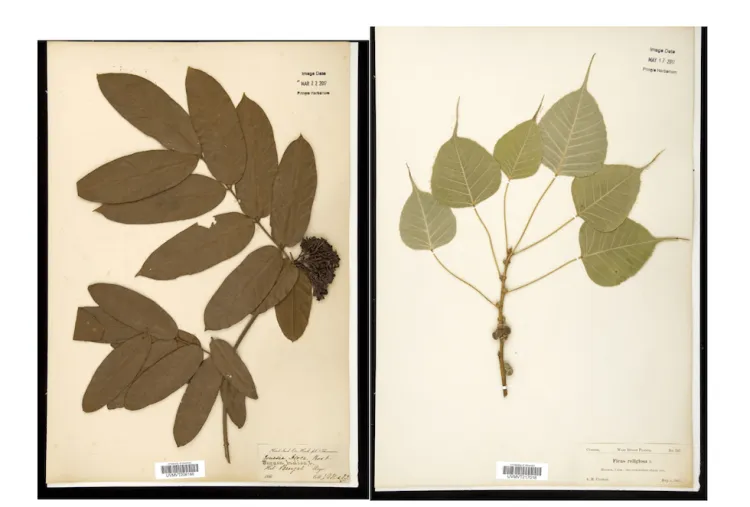
On the left is a specimen of "Saraca indica" in the Pringle Herbarium that was collected from Bengal, India. On the right is the only specimen of "Ficus religiosa" in the Pringle Herbarium, collected from Cuba. Both of these trees are native to Southern and Southeastern Asia, and play an important role in Hindu and Buddhist beliefs.
Many plants are associated with the Jewish culture, and are often used on holidays and in religious ceremonies to convey meaning or represent a story. There are “seven species” or “shivat haminim” that are considered special products of the land of Israel as they were some of the first domesticated plants in the Middle East and seen as a symbol of God’s love. The seven species are wheat (Triticum), barley (Hordeum vulgare), grapes (Vitis), figs (Ficus carica), pomegranates (Punica granatum), olives (Olea europaea), and dates (Phoenix dactylifera).

"Ashkenazi Herbalism" by Deatra Cohen and Adam Siegel is available in the Howe Library. It provides in-depth information about medicinal plant knowledge of Ashkenazi herbal healers from the middle ages through the 20th century.
The pomegranate (Punica granatum), for example, is believed to contain exactly 613 seeds, which symbolize the 613 mitzvot, or sacred obligations of the Jewish people, which comprise the foundation of traditional Jewish practice. The olive (Olea europaea) is a symbol of peace, as used in the story of Noah’s Ark when a dove returns carrying an olive branch to inform Noah of the end of the storm.
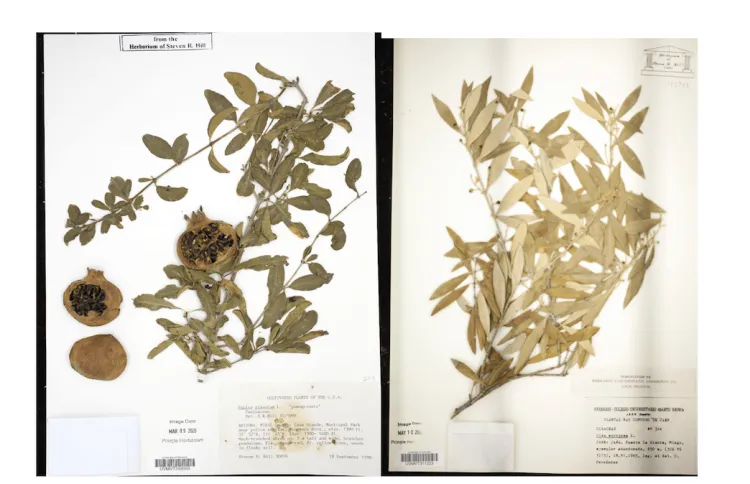
These specimens from the Pringle Herbarium are both part of the “seven species.” The seven species are all integrated into three important Jewish holidays. One of these is Tu B'Shvat, which celebrates ecological awareness and means “New Year of the Trees”;trees are planted on this day in celebration. On the left is a pomegranate ("Punica granatum") specimen and an olive ("Olea europaea") branch is on the right.
Plants have been of great importance to religious and spiritual groups beyond those we hear of in Western media. Plants like the olive tree and lotus are well known in our mainstream culture, and these plants and others like them are widely used symbols, and can often be seen tattooed on people who feel strongly about their meaning. A plant that is less widely known in some of the major global religions is peyote (Lophophora williamsii). Peyote is a member of the Cactaceae family and is native to Mexico and southwestern Texas. It has been used as a religious sacrament by Indigenous peoples of the region for thousands of years for medicinal purposes or to induce supernatural visions and commune with spirits. Although it is now illegal in most US states, it is protected for traditional Indigenous use through the American Indian Religious Freedom Act.
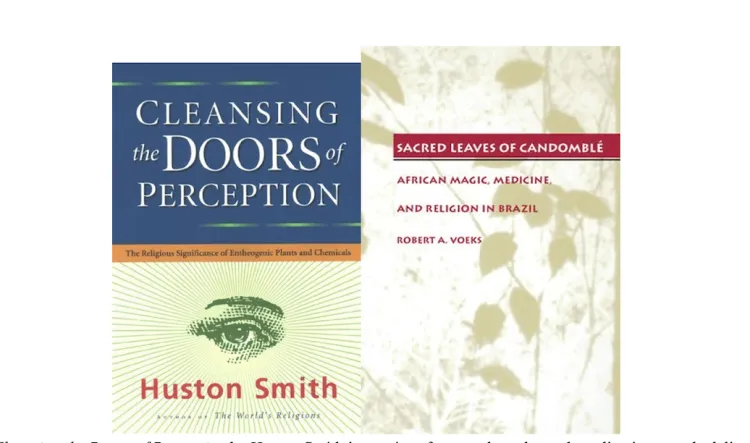
"Cleansing the Doors of Perception" by Huston Smith is a series of essays that takes a deep dive into psychedelic drugs used to achieve union with divine beings. It includes a chapter on peyote ("Lophophora williamsii"), a cactus containing psychoactive alkaloids. "Sacred Leaves of Candomblé" by Robert A. Voeks traces the origin, diffusion, medicinal use, and meaning of Candomblé's healing plants. Candomblé is an African-Brazilian religion that combines traditional West and Central African religions with Roman Catholicism. Both of these books are available in the Howe Library.
Another lesser known religious practice from the southern hemisphere is Candomblé, a belief system now practiced by around 2 million people in Brazil, Argentina, Venezuela, Uruguay, and Paraguay. It was developed by enslaved African peoples in South America, and includes elements of African cultures, Catholicism, and indigenous South American beliefs. The amalgamation of the different belief systems that resulted in the practices of Candomblé have led to a wide variety of uses of herbs and plants in the religion. There are many plants used for medicinal purposes, and some specifically in rituals held by Candomblé priests and priestesses in which they are employed for their cleansing purposes through means of smoke or bathing. Some of the plants important to these people include Justicia gendarussa, and Sansevieria spp. Sacred Leaves of Candomblé by Robert A. Voeks explores many of these plants and their uses, and is available in the Howe Library.
I have barely scratched the surface of plants tied to religious or spiritual practices and beliefs. The University of Vermont has many resources on this kind of information, much of which can be found in the Howe Library. There are many books that cover a broad spectrum of plants and their usefulness or significance to ancient and modern cultures.
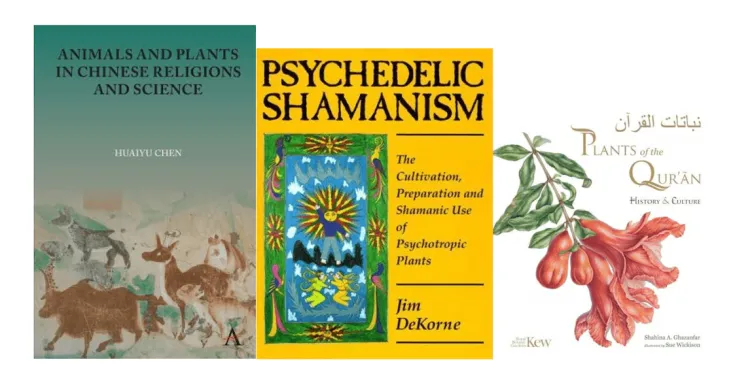
Three examples of books that are available in the Howe Library and cover various plants and their significance in cultures and religions around the world. UVM’s offerings on this topic cover not only a range of different belief systems, but also a range of different plants. As such, they are excellent sources on not only religious and spiritual diversity, but also biological diversity of plants, and display the ways in which these two facets are connected.
By Kylie Roth
References
Ashoka. (2017). Sacred Trees of BHU. Retrieved November 15, 2024, from http://sacredtreesbhu.com/index.php?id=AshokTree
Belhumeur, J. (2022). How peyote — used as a ceremonial, legal medicine — helped heal one family’s grief. Rocky Mountain PBS. Retrieved November 15, 2024, from https://www.rmpbs.org/blogs/native-lens/peyote-healing-after-covid-loss
Chandrasekar, S.B. Bhanumathy M, Pawar AT, Somasundaram T. (2010) Phytopharmacology of Ficus religiosa. Pharmacognosy Review, (4)8, 195-199. https://doi.org/10.4103/0973-7847.70918
Encyclopedia Britannica (2024). Native American Church | Peyote Religion, Ceremonies & History. Encyclopedia Britannica. Retrieved November 15, 2024, from https://www.britannica.com/topic/Native-American-Church
Encyclopedia Britannica. (2024, November 5). Sacred lotus | Description, Edible, Uses, Symbolism, & Facts. (2024). Encyclopedia Britannica. Retrieved November 15, 2024, from https://www.britannica.com/plant/sacred-lotus
My Olive Tree. (2018). The Symbolism of the Olive Tree in the Jewish Faith - Sponsor an Olive Tree in Israel. Retrieved November 15, 2024, from https://www.myolivetree.com/symbolism-olive-tree-jewish-faith/
National Parks Board. (n.d.). Ficus religiosa L. Flora & Fauna Web. Retrieved November 15, 2024, from https://www.nparks.gov.sg/florafaunaweb/flora/2/9/2915
Pagnocca, T.S., Zank, S. & Hanazaki, N. (2020). “The plants have axé”: investigating the use of plants in Afro-Brazilian religions of Santa Catarina Island. J Ethnobiology Ethnomedicine (16)20. https://doi.org/10.1186/s13002-020-00372-6
Plant Pono. (n.d.). Saraca asoca (ashoka tree). Retrieved November 15, 2024, from https://plantpono.org/pono-plants/saraca-asoca/
Pokharel, N., Adhikari Pokharel, B. (2021). A Relationship Between Plants and Their Hindu and Buddha Cultures: An Analysis Ficus Religiosa (Pipal). In: Niglio, O., Lee, E.Y.J. (eds) Transcultural Diplomacy and International Law in Heritage Conservation. Springer, Singapore, 143-151. https://doi.org/10.1007/978-981-16-0309-9_10
Reform Judaism. (n.d.). What are the Seven Species? Retrieved November 15, 2024, from https://reformjudaism.org/jewish-holidays/tu-bishvat/what-are-seven-species
Rudy, L. J. (2019, August 5). What Is Candomblé? Beliefs and History. Learn Religions. Retrieved November 25, 2024, from https://www.learnreligions.com/candomble-4692500
Siegelbaum, C. B. (n.d.). The Seven Species. My Jewish Learning. Retrieved November 15, 2024, from https://www.myjewishlearning.com/article/the-seven-species/
Ward, W. E. (1952). The Lotus Symbol: Its Meaning in Buddhist Art and Philosophy. The Journal of Aesthetics and Art Criticism, (11)2, 135–146. https://doi.org/10.2307/426039
Wen, F. S. (n.d.). Religion’s Living Roots: The Sacred Ficus religiosa. Biodiversity Stories. Retrieved November 15, 2024, from https://www.juncture-digital.org/Digital-Scholarship-NUS-Libraries/biodiversitystories/Sacred%20Fig